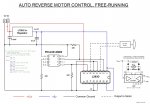Teedoubleudee
Member
Hi, I have built the attached circuit but can't get it to work. If I place a high (5v) on pins 5 OR 7 (C0 or C2) (with the 08M2 removed) then the motor will turn in either direction as designed. But the 08M2 does not seem to be able to drive it. All I get is a slight twitch at each 20 second interval as if it's trying which appears to prove the code is at least running. Any ideas?
Attachments
-
198.2 KB Views: 40

